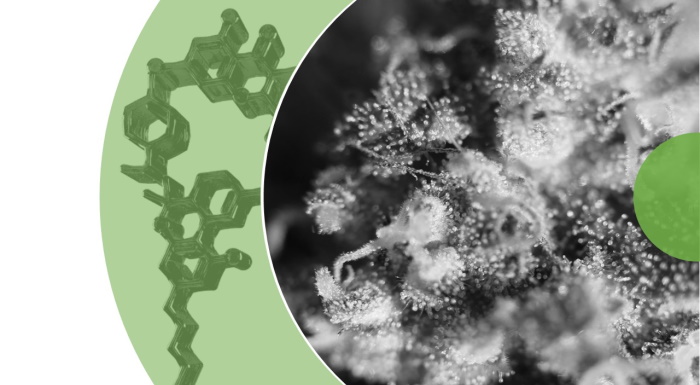There are 7 primary ways to manipulate the terpene content of cannabis. These methods involve manipulation of terpene content prior to drying and curing, whereafter only preservation is possible. These brief descriptions are based on a supplemental chapter in The Big Book of Terps titled “Manipulating Cannabis for Phytochemical Content,” which begins at page 556.
#1 – Genetics: Terpene Content Depends on Genetics
Controlling the terpene content of cannabis begins with selecting stabilized cannabis genetics that are known to produce the phytochemical profile desired. Genetic code contains the blueprint for the terpene and phytochemical content that can be produced under ideal conditions. Any deviation from the plant’s genetic ideal is generally caused by environmental influence as detailed below.
#2 – Harvest Timing: Monoterpenes Evaporate with Heat and Light
a. Seasonal
Cannabis cultivators have long known that trichome ripeness determines several end-product variables, including taste, smell, and effects. Trichomes contain mostly terpenes, which means that harvesting based on trichome ripeness is the same as harvesting based on terpene content and state. We need cultivators worldwide to test live plant volatile molecule content at each stage of the traditionally harvested metrics – clear trichome heads, cloudy trichome heads, and amber trichome heads – to determine the resulting terpene and other phytochemical content at each stage. These tests must also include studies where subjects consume products from each stage and report on subjective effects.
b. Daily
When it comes to the volatile organic compounds of cannabis, we’re mostly talking about monoterpenes, sesquiterpenes, diterpenes, and triterpenes, which are listed here in order of volatility. Because monoterpenes are the most volatile, they evaporate quickly under heat and/or light. Therefore, to retain the most monoterpenes possible, the ideal time to harvest cannabis is early in the morning, before the sun heats and lights the environment.
#3 – Disease Stress: Plants change Terpene Content in Response to Disease
When plants are stressed by disease, they often adjust the composition of their phytochemical content and emissions to help fight the infection. This can be capitalized upon by cannabis growers by deliberately exposing crops to bacterial, viral, or other diseases where a cure is available (fungi and bacteria provide the clearest examples of curable conditions). Measurements of phytochemical content should be taken prior to disease exposure, at several periods during exposure, and after treatment has been applied. This type of experimentation should be considered for manufacturing processes that can later remove molds or bacteria.
#4 – Insect Stress: Plants Change Terpene Content and Emissions in Response to Insect Behavior
When insects gather on, consume, or lay eggs on plants, many plants respond by significantly altering phytochemical content, particularly terpenes. Similar to the above description of disease stress, cannabis plants can be forced to alter their phytochemical content by exposing them to an insect infestation such as aphids or spider mites. Assuming a cure is on hand (such as ladybugs or acaricidal agents), the plants can be tested prior to commencement of the experimentation, again 1-2 days after exposure to the insects, and again after treatment, or more often for projects with access to ample resources.
#5 – Allelochemical Stress: Plants Change Volatile Terpene Emissions in Response to Other Plants
When plants use emissions of volatile molecules like terpenes to influence the growth of other plants, these are called allelopathic agents, where the “attacking” plant and the “defending” plant both alter their phytochemical content to engage in this warfare. Cultivators can alter the content of terpenes and other phytochemicals by co-planting competing plants near cannabis plants. In this case, laboratory testing of terpenes and other chemicals must occur prior to co-planting, at several points during the co-planting period, and, to confirm results, after removal of the offending cohabitant species.
#6 – Mechanical Wounding: Plants Change Terpene Content in Response to Injury
One interesting way to manipulate terpene content in specific parts of a plant is to mechanically wound the plant. When wounded, many plants send a rush of specific blends of terpenes and other compounds to the site of injury. While this is useful for experimentation purposes, the results will not be systemic and therefore will not affect harvestable flowers, unless flowers are the site of injury.
#7 – Chemical Treatment: Plants Change Terpene Content in Response to Other Chemicals
Some plants respond to treatment with organic chemicals by altering their terpene profile. While this is possible using several different compounds, one chemical that often elicits phytochemical changes in plants is gaseous emissions of limonene. Much experimentation is needed to elucidate the potential in this regard for cannabis.
Finally, drying, curing, and processing are not necessarily ways to manipulate terpene content, but rather ways to preserve these chemical profiles. It is possible to produce a deliberate ideal phytochemical content of a particular chemovar and crop, but then destroy that chemical content during drying and curing. As with all terpenes but especially for monoterpenes, heat and light will dramatically change phytochemical content, and not generally in a favorable way for consumers.
